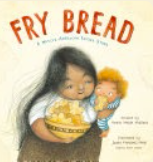Fry Bread Book Review
Fry Bread
1. BIBLIOGRAPHY
Maillard, K. (2019). FRY BREAD. Roaring Brook Press. ISBN: 978-1-62672-746-5
2. PLOT SUMMARY
This picture book tells the story of fry bread using the sentence stem” Fry Bread is” on each page for each verse. Fry Bread speaks to the history of fry bread and how it is still embraced culturally.
3. CRITICAL ANALYSIS
In Fry Bread, the story is based on the history of fry bread in the Native American culture. The characters on the pages are of American Indian descent, while showing how broad the differences are from dark hair to red hair to blonde hair. Their skin tones also range in different hues. Their clothing is also indicative of their heritage; some of the characters wear skirts and clothing of Native Americans with vibrant patterns. The man illustrated in the story has tribal tattoos, which are explained in the author’s notes at the end of the book to be Seminole.
There are numerous references to the Native American culture in Fry Bread. Beginning with the characters’ hair texture and skin tone, they depict a variety of the tribes appropriately. Their traditional and nontraditional clothing also reflect their diversity. The fry bread: how it is made and how it is shared through generations. Native American culture is represented by the baskets being woven and how the family gathers to make fry bread together; it is a special occasion. Also, the history of the fry bread and how Native Americans were displaced off their lands and given unhealthy foods as a replacement.
The pictures in this book use colors to represent the Native American culture. The most distinctive part of some pictures is the history of Native Americans. There are maps, a tribal memorial wall, and ancestors with the moon. Martinez-Neal's illustrations of baskets and handmade dolls were inspired by the culture. There is also a traditional rug with patterns on the last page. On kitchen pages, there is wall artwork, pottery, woven baskets, and pictures of Maillard’s aunt, who made fry bread for him as a child. The inside of the front and back covers name a multitude of tribe,s which are not repeated, and say “and many more” on the back. This shows the inclusion of all tribal nations.
4. REVIEW EXCERPT(S)
ALA Notable Children's Books, 2020
American Indian Youth Literature Honor, 2020
Booklist starred, 09/01/19
Horn Book Magazine, 11/01/19
Kirkus Reviews starred, 07/15/19
New York Times, 11/03/19
Publishers Weekly starred, 08/05/19
Robert F. Sibert Informational Book Medal, 2020
School Library Journal starred, 10/01/19
Full-Text Reviews
Booklist starred (September 1, 2019 (Vol. 116, No. 1))
Grades K-2. Fry Bread celebrates the thing itself and much, much more. The simplicity of the ingredients, readers learn, belies the quality of the cooking process, the proximity with people, the historical tradition, the geography—for “fry bread is everything.” Maillard and Martinez-Neal bring depth, detail, and whimsy to this Native American food story, with text and illustrations depicting the diversity of indigenous peoples, the role of continuity between generations, and the adaptation over time of people, place, and tradition. Fry bread becomes a metaphor for resilience, born ironically, as Maillard explains, from the most basic of government-issued ingredients. Martinez-Neal’s (Alma and How She Got Her Name, 2018) illustrations are meant to be relished, lingered over. Smiling, round-faced children are shown playing together and learning from elders, and details include traditional Seminole textile designs, dollmaking, and pottery styles. A particularly striking spread depicts a wall etched with the names of hundreds of Native American nations, explicitly countering perceptions about the extinction or invisibility of indigenous peoples. A lengthy author’s note provides valuable context and history, as well as the author’s personal evolution into the “fry bread lady” with his own modern take on the recipe. This lovely, important book pairs well with Linda Sue Park’s Bee-bim Bop! (2005) and Hot, Hot Roti for Dada-ji (2011) by F. Zia for fun culinary, familial themes.
5. CONNECTIONS
Related Books:
Muth, J. J. (2015). Hi, Koo! Scholastic Inc. ISBN: 9780545777643
Aylesworth, J. (2001). THE BURGER AND THE HOT DOG. Atheneum Books for Young Readers. ISBN: 9780689838972
Activities:
Students can research a Native American tribe and create a meaningful presentation.
Make fry bread in class together.



Comments
Post a Comment